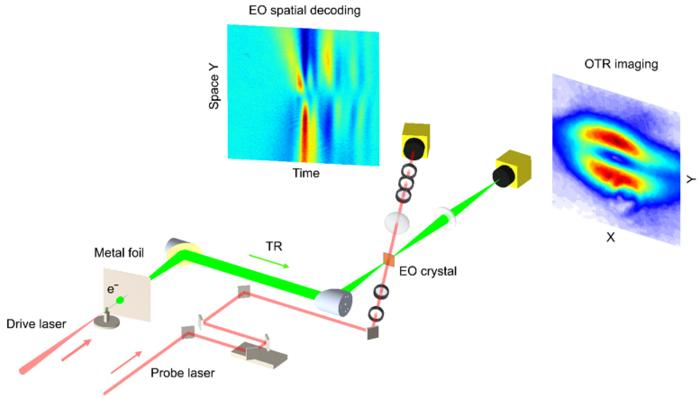Laser wakefield acceleration (LWFA) is a technology developed by T. Tajima and J. Dawson that uses high-intensity laser pulses to drive plasma waves with acceleration gradients orders of magnitude higher than those of traditional RF-based accelerators. By considering the laser pulse as a bullet, the ponderomotive force causes the plasma to behave like an RF cavity and produce a periodic wave.

Relativistic electron bunches were generated via the incidence of a high power laser onto a gas jet. The TR radiation emitted when electron passing through a metal foil was imaged to an EO crystal. OTR imaging and EO spatial decoding were conducted simultaneously to achieve the electron spatial-temporal profile in a single shot. Image Credit: Kai Huang, Zhan Jin, Nobuhiko Nakanii, Tomonao Hosokai, and Masaki Kando
This wave’s trapped electrons can accelerate to GeV energies (1 GeV = 10Fci eV) in just 1 cm, which is a thousand times faster than traditional accelerators. Electron bunches from LWFA have temporal durations of femtoseconds, which offer unparalleled possibilities for ultrafast investigations. Significant progress has been made in LWFA over the last 20 years in terms of maximum energy, energy spread, charge, and repetition rate.
The great acceleration gradient and high-brightness electron bunches that can be generated by LWFA make it a highly promising tool for time-resolved dosimetry, X-Ray pump-probe studies, and high-energy physics.
The three-dimensional (3D) density plays a pivotal role in influencing the luminosity of a collider, the brightness of secondary X-Ray sources, and the peak radiation dose rates.
In particular, the lasing process in an undulator is closely connected to a tabletop X-Ray free-electron laser (XFEL). However, the lack of diagnostic techniques has made experimental measurement elusive up until now. Although the relative longitudinal and transverse distributions have been examined independently, the absolute 3D density profile is still not fully understood.
Researchers led by Dr. Masaki Kando of the Kansai Institute for Photon Science (KPSI), National Institutes for Quantum Science and Technology (QST), Japan, Prof. Tomonao Hosokai of SANKEN, Osaka University, Japan, and associates have made significant progress in single-shot monitoring of the 3D density profile of LWFA electron bunches. The study was published in the journal Light Science & Application.
Through rigorous experimental and numerical inquiries into optical transition radiation (OTR) imaging, electro-optic (EO) spatial decoding, and genetic algorithm (GA), researchers have achieved the successful reconstruction of detailed 3D structures of ultrafast electron bunches stemming from Laser Wakefield Acceleration (LWFA). This breakthrough sheds light on the intricate beam dynamics of the electron bunch, marking a significant advancement in the field.
The findings unveil an electron bunch with a transverse size of less than 30 micrometers, showcasing the remarkable resolution attained through the OTR imaging technique. In addition, the current profile displayed a multi-peak shape that was complex and had a peak current of more than 1 kA in a sub-10 femtosecond structure. This is evidence of the remarkable performance of laser wakefield acceleration.
The observed peak 3D number density of approximately 9 × 1021 m-3 holds particular significance, providing invaluable insights into the accelerated electron bunch. This groundbreaking detection highlights the potential for deploying a detector at any position along a beam transport line, thereby paving the way for novel applications in accelerator science and beyond.
The ability to measure the three-dimensional density profile of electron bunches will enhance our understanding of LWFA and unlock its full potential for diverse applications. The results and methodologies presented in this article have far-reaching implications across a spectrum of disciplines, including accelerator physics, high-power lasers, and terahertz optics.
Dr. Kai Huang, Senior Researcher and Study Lead Author, National Institutes for Quantum Science and Technology
This study demonstrates QST’s dedication to advancing quantum science and technology, establishing world-leading research and development platforms, and venturing into new frontiers. Through these efforts, QST is poised to make substantial academic, social, and economic impacts.
Journal Reference:
Huang, K., et al. (2024) Electro-optic 3D snapshot of a laser wakefield accelerated kilo-ampere electron bunch. Light: Science & Applications. doi.org/10.1038/s41377-024-01440-2